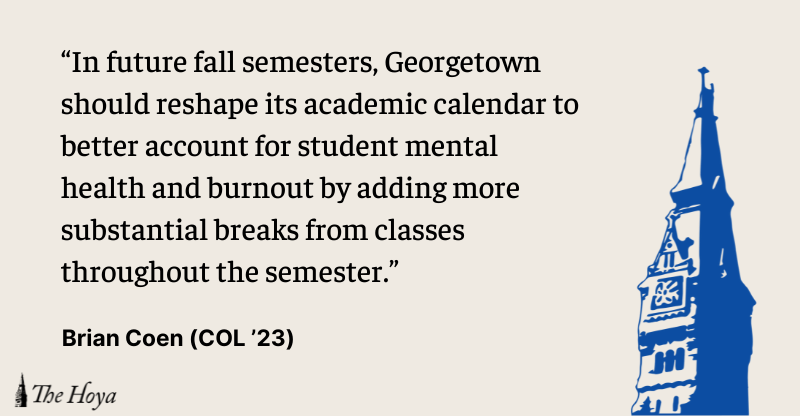This past Monday marked Indigenous People’s Day in the United States and the midsemester holiday for Georgetown University students. The day off provided students with a much-needed break from their classes to rest and recharge.
For many students, however, the break is short-lived and the rest is inadequate. In future fall semesters, Georgetown should reshape its academic calendar to better account for student mental health and burnout by adding more substantial breaks from classes throughout the semester.
Currently, the university offers undergraduate students only four days off during the fall semester: Labor Day, Indigenous People’s Day, Thanksgiving Day and the day after Thanksgiving. These four days off are spaced out between 70 days of regularly scheduled classes. The lack of substantial breaks from classes places an immense amount of pressure on Georgetown students and does not allow students to build meaningful personal time into their schedules. The demand of constantly working without taking breaks takes a toll on students and diminishes their ability to be productive. Studies also show that taking more time off can help promote mindfulness, improve sleep quality, decrease stress, aid brain function and even boost heart health.
Georgetown has amended its academic calendar in the past to better accommodate the mental health of its students. After the fall 2020 semester, the university registrar announced an extended winter break to account for burnout and “Zoom fatigue.” The announcement came as a relief for many students, who were in need of a break after an exceptionally difficult semester. The extended winter break was a step in the right direction, but the mental health of students should matter every year, not only during a global pandemic. Therefore, Georgetown should take this opportunity to demonstrate its commitment to promoting mental health outside the extraordinary circumstances of an entirely online academic year.
Further, when compared to other Jesuit universities around the country, Georgetown offers its students less time off to relax. Several schools that also operate on a semester system, including Creighton and Holy Cross, give their students an entire week off in October. Other Jesuit schools like Marquette and Xavier opt to give their students two days off in October to serve as a fall break. While this time off is not much, it is still more than Georgetown offers. If Georgetown is truly committed to the Jesuit values that it promotes, particularly cura personalis, then it should follow the example of other Jesuit schools and enact more time off to allow students to prioritize “care for the whole self.”
Another common difference between Georgetown’s academic calendar and other universities’ schedules concerns the week of Thanksgiving. Many schools do not hold classes on the Wednesday before Thanksgiving, making Georgetown one of the few schools in the country that expects its students to attend classes on the day before the holiday. Georgetown prides itself on attracting students from all over the country and the world. However, the university’s current structure for Thanksgiving break does not accommodate students who live far away from Washington, D.C., hindering those students from getting meaningful time at home. Having time to relax away from campus is important for the mental health of students, and adding an extra day to Thanksgiving break would help alleviate a lot of stress for students, especially those who do not live nearby.
The distinct lack of breaks in Georgetown’s fall semester becomes even more puzzling when considering the university’s spring academic calendar. In a typical spring semester, Georgetown gives students a more substantial amount of time off compared to a fall semester. In the spring 2022 semester, Georgetown students will receive 10 days off throughout the semester, more than doubling the total number of holidays in fall 2021. If Georgetown sees it fit to give its students 10 days off in the spring, it makes sense for the university to add more than four days off in the fall. If Georgetown is willing to give its students a spring break, the university should also give its students a fall break.
Going forward, the university should allot one week in October to serve as a fall break or give its students the entire week of Thanksgiving off. Such a policy change would immensely improve the mental health of students, faculty and staff, as everyone would be more refreshed and refocused. The decision to enact this change should be an easy one and is long overdue.
Brian Coen is a junior in the College.














